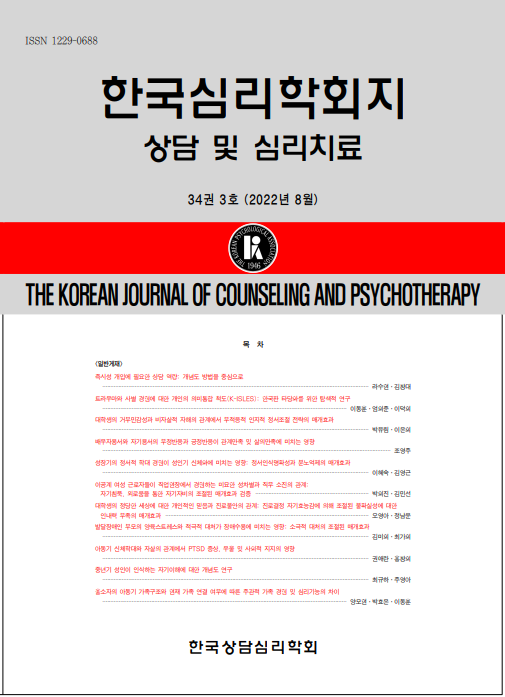open access
메뉴
open access
메뉴 ISSN : 1229-0688
ISSN : 1229-0688
This paper consists of two studies. In Study 1, Covert Narcissism Scale(CNS) and Working Alliance Inventory(WAI) were administered to 63 clients from university counseling centers before session 1 or 2 and after session 3 accordingly. Analysis revealed that clients with higher CNS perceived less Working Alliance. Sub-factors of Working Alliance showed negative correlation with inner-goal-instability of Covert Narcissism. In Study 2, among high CNS cases, two each with high and low Working Alliance were analyzed from a counselor-client complementarily viewpoint.In the former cases, both displayed friendly responses in affiliation relations. In control dimension, counselors showed dominant, and clients, docile responses. In the latter, clients displayed hostile, and counselors, friendly responses and the same results were shown for the control dimension.
강연우 (2004). 자기애와 방어유형 및 대인관계 특성의 관계. 가톨릭대학교 석사학위 논문.
강선희 (2002). 내현적 자기애 척도의 개발 및 타당화. 가톨릭대학교 석사학위 논문.
김선경 (1992). 초기 협력관계의 지각과 언어 상호작용 유형과의 관계 분석. 서울대학교 석사학위 논문
김윤주 (1991). 자기애적 성격과 자기복합성의 관련성에 대한 연구. 고려대학교 석사학위 논문
권석만, 한수정 (2000). 자기애성 성격장애. 서울: 학지사.
방기연 (1991), 상담 초기 작업동맹과 상담자 반응 간의 관계. 서울대학교 석사학위 논문
정남운 (1998). 상담과정에서의 대인관계적 상보성과 상담성과. 서울대학교 박사학위 논문.
정남운 (2001). 과민성 자기애 척도(HSNS) 타당화 연구. 한국심리학회지: 상담 및 심리치료, 13(1), 193-216.
최종순 (2003). 자기애적 성격특성과 자기표현이 대인관계에 미치는 영향. 홍익대학교 석사학위 논문.
한수정 (1999). 자기애적 성격성향자의 외현적, 내현적 자기관련 인지특성. 서울대학교 석사학위 논문.
Akhtar, S., & Thomson, J. A. (1982). Overview: Narcissistic Personality Disorder. American Journal of Psychiatry, 139, 12-20
Bordin, E. S. (1979). The Generalizability of the psychoanalytic concept of the working alliance. Psychotherapy, 16, 252-260
Carson, R. C. (1969). Interaction concepts of personality. Chicago: Aldine.
Claiborn, C. D. & Strong. S. R. (1982). Group counseling in the schools. The handbook of school psychology, 530-553.
Ellis, H. (1898). Auto-eroticism: A psychological study. Alienist and Neurologist, 19, 260-299
Freud, S. (1926). On Narcissism: An introduction, S.E., 14, (pp. 73-102)
Freud, S. (1953). On Narcissism.: An Introduction. London.: Hogarth Press, (Priginal work published 1914).
Friedlander, M. L. & Phillips, S. D. (1984). Preventing Anchoring Errors in Clinical Judgement. Journal of Consulting and Clinical Judgement, 366-371
Greenson, R. (1967). The technique and Practice of Psychoanalysis, New York: International Universities Press
Hendin, H. M., & Cheek, J. M. (1997). Assessing hypersensitive narcissism: A reexamination of Murray's narcissism scale. Journal of Research in Personality, 31(4), 588-599
Highlen, P. S., & Hill, C. E. (1984). Factors affecting client change in individual counseling; Current status and theoretical speculation. In S. Brown & R. Lent (Eds.), Handbook of counseling psychology (pp. 334-396). New York: Wiley
Horvath, A. & Greenberg, L. (1986). Development of the working alliance inventory. In L. Greenberg & W. Pinsof(Eds.), Psychotherapeutic Process: A research handbook. New York Guildford Press
Horvath, A. & Greenberg, L. (1989). The working alliance inventory. Journal of Counseling Psychology, 36, 223-233
Kiesler, D. J. (1983). The 1982 interpersonal circle: a taxonomy for complementarity in human transactions. Psychological Review, 90(3), 185-214
Lasch. C. (1979). The Culture of Narcissism: American Life in an Age of Diminishing Expectations
Leary. T. (1957). Interpersonal diagnosis of personality: A functional theory and methodology for personality evaluation. New York: Ronald Press.
O'Malley, S. S., Suh, C. S., & Strupp, H. H. (1983). The Vanderbilt Psychotherapy Process Scale: A report on the scale development and a process-outcome study. Journal of Consulting and Clinical Psychology, 51, 581-586.
Rathvon, N., & Holstrom, R. W. (1996). An MMPI-2 portrait of narcissism. Journal of Personality Assessment, 66, 1-19
Reandeau, S. G. & Wampold, B. E. (1991). Relationship of power and involvement to working alliance: A multiple-case sequentialanalysis of brief therapy. Journal of counseling Psychology, 12, 107-114.
Strong, S. R. (1986). Interpersonl influence theory and therapeutic interactions. In F. J. Dorn (Ed.), Social influence processes in counseling and psychotherapy (pp.17-30). Springfield, IL: Thomas.
Strong, S. R. Hills, H. I., & Nelson, B, N. (1988). Interpersonal Communication Rating Scale (Revised). Richmond: Virginia Commonwealth University.
Strupp, H. H., & Hadley, S. W. (1979). Specific versus nonspecific factors in psychotherapy: A controlled sutdy of outcome. Archives of General Psychiatry, 36, 1125-1136
Tracy, T. J., Heck, E. J., & Lichtenberg, J. W. (1981). Role expectations and symmetrical /comlementary therapeutic relationships. Psychotherapy: Theory Research and Practice, 18, 338-344.
Tracy, T. J. & Ray, P. B. (1984). The stages of successful time-limited counseling: An international examination. Journal of Counseling Psychology, 31, 13-27.
Tracey. T. J. & Guinee. J. P. (1990). Generalizability of Interpersonal Communications Rating Scale ratings across presentation mode. Journal of Counseling Psychology, 37, 330-336
Watzlawick, P. & Weakland, J. (1977). The International View: Studies at the Mental Research Institute Palo Alto 1865-1974. New York: Norton
Welberg, L. R. (1989). Techniques of Psychotherapy. New York: Grune & Stration
Wink, P. (1991). Two faces of narcissism. Journal of Personality and Social Psychology, 61, 590- 597
Wink, P. (1992). Three types of narcissism in women from college to mid-life. Journal of Personality, 60(1), 7-30
